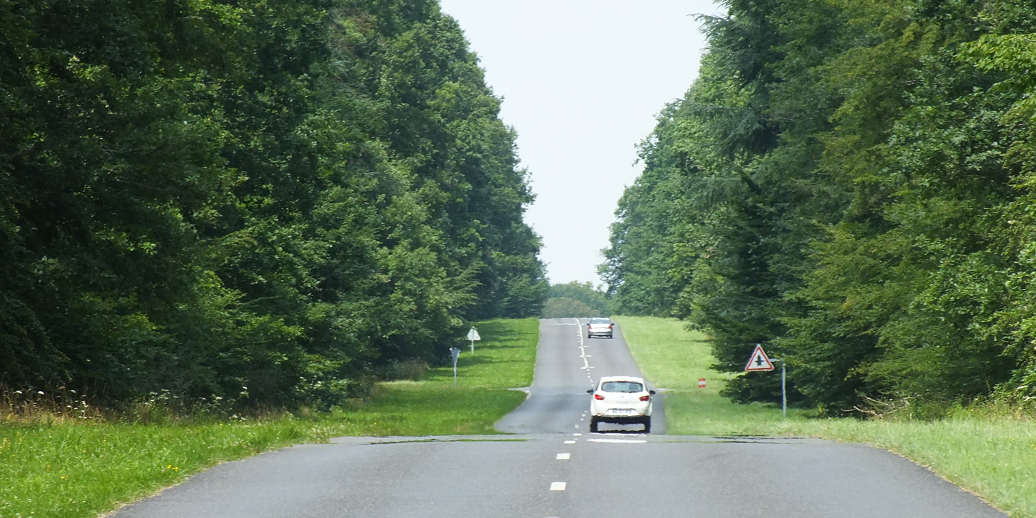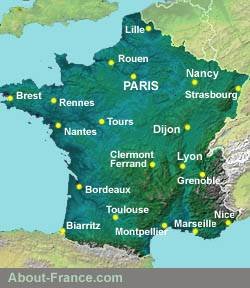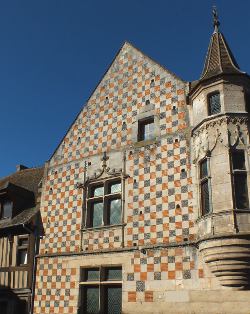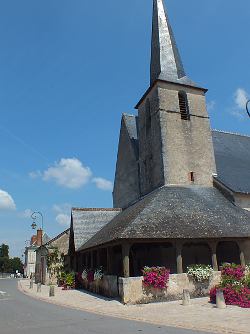
Byroads through France
Part
1
From Dieppe to the Centre of France on byways
About-France.com
- Explore France ►
- Essential pages
- Travel in France
- Where to go
- What to see and do
About-France.com
- the connoisseur's guide to France
| On this page | Route description | Route map and accommodation |
In
part 1 of
this guide to Byroads
through France, we take you on small hassle-free roads
from Normandy,
as far as Saint Amand
Montrond, the small town that is located closest
to the geographic centre of continental France.
Follow the route on the interactive map.
Where
to stay
About-France.com has selected a range of hotels along the route. Click markers for more details. There are also campsites and motorhome overnighting areas in many of the small towns along the way.
For electric vehicles ⚡: Finding hotels with EV charging points is not always easy, but we've noted EV-friendly hotels in Chartres and Bourges. Check the hotel markers on the map for these locations.
About-France.com has selected a range of hotels along the route. Click markers for more details. There are also campsites and motorhome overnighting areas in many of the small towns along the way.
For electric vehicles ⚡: Finding hotels with EV charging points is not always easy, but we've noted EV-friendly hotels in Chartres and Bourges. Check the hotel markers on the map for these locations.
Route
guide part 1:
from Dieppe or Rouen to the centre of France
Starting from Dieppe
Map Key: see
below
This
route starts at Dieppe★★, the
small old-style French
Channel port with ferries from Newhaven (see DFDS Ferries).
Dieppe, with its
harbour, its old town, its unique revolving Colbert bridge, and other
sights, is officially classed as an "art and history town" (Ville d'art et d'histoire).With a long journey ahead of you, after visiting Dieppe you may like to head south on the dual carriageway N27 and go through, or visit, ★★★ Rouen, but if modern highways are a no-no for you, leave the dual carriageway at Manéhouville, taking the exit marked D108 for Auppegard. At the roundabout, follow the D927 signposted Braqueville. Don't turn off for Braqueville; keep following the N927, which used to be the main road to Rouen before the new dual carriageway was built. If continuing on the dual carriageway, leave it at the exit for Totes. You're going through a historic area of rural Normandy, known as the Pays de Caux.
After Tôtes, turn right onto the D22 in the direction of Pavilly. Keep following the D22 out of Pavilly, as far as Bouville, where you join the D63, which you'll follow until it reaches the D5 just before the village of ★ Duclair, on the banks of the Seine.
The question now is how to cross the Seine? Well there's an easy answer.... by ferry ★. Until the building of the great Seine bridges downstream of Rouen in the late 20th century, crossing the river anywhere northwest of the city involved taking a ferry – and six of the old ferry services are still in operation today. What's more, they're free.
You could take the ferry from Duclair, but for a more scenic route we suggest carrying on for another 7.5 km to Jumièges, with its great ruined Benedictine abbey ★★, one of the finest ruins in France and on a par with the great ruined abbeys in the UK, such as Tintern Abbey or Fountains Abbey.
There are ferries from Jumièges to Heurteauville, and from le Mesnil sous Jumièges to Yville. Most ferries run at least twice an hour every day of the week, with the Duclair to Berville ferry running every 20 minutes from 5 a.m. to after 10 p.m.
Once over the river, follow signs for Bourg Achard. From Bourg Achard, follow the D913 as far as Infreville, then follow the D80 as far as La Haye du theil, and on to le Neubourg.
Starting from Rouen
Alternatively, start at Rouen, a historic city on the river Seine, and home to one of France's greatest medieval cathedrals. Rouen (population 111,000) is the only big city on the whole route. Rouen can be easily reached from the main Channel ports of Calais, Dieppe, Le Havre, Caen and Cherbourg (See Ferries to France).★★★ Rouen is an attractive riverside port city, boasting one of the finest medieval cathedrals in France. The old city around the cathedral is a maze of narrow streets with many half-timbered houses. Among the other great sights in the old city are the Gros Horlorge, a 14th century astronomical clock on the facade of a Renaissance arch, and the Renaissance Law Courts (Palais de justice), formerly the Norman parliament building.
Leave Rouen following signs for Elbeuf . One way or another, you should get onto the D 938 or the D7 (from exit 21 on the A13 motorway), both of which lead to Elbeuf. Leave Elbeuf on the D840 following signs for Le Neubourg.
Both routes, from Le Neubourg
| Map Key: (clickable
markers) |
|
 |
Quality / classic independent hotels or B&B with character |
 |
Four-star and quality three star hotels - chains such as Mercure or Novotel |
 |
Budget and economy hotels - 2 or 3 stars
chains such as Ibis or Campanile |
 |
Independent budget hotels |
 |
Hotel clusters: more than one hotel of different categories |
| Other map markers: the clickable o markers on the route locate and give key information on places described in the route guide | |
After Le Neubourg, follow the D840 all the way to Verneuil sur Arve. The road is mostly straight. Before Verneuil, you will drive through, or skirt round, two small towns: Conches en Ouche ★ is an attractive small town with a fine flamboyant gothic church, the remains of a medieval keep, and other historic sites. Further on, Breteuil is a small town with a 12th century church and some typical Norman half-timbered houses.
Verneuil sur Arve ★★ is listed by Michelin as one of the 100 small places in France that are "worth a detour". Among its sights, the small town has a fine gothic church with an impressive flamboyant tower, and several noteworthy Renaissance town houses.
Leave Verneuil following signs for Brezolles and Chartres. The D839 becomes the D939 just outside town, when you leave Normandy and move on into the Centre-Val de Loire region. You'll follow the D939 all the way to Chartres, which will probably be your next stopping point.
Chartres ★★★ is a small city of 38,000 inhabitants, and the site of one of the finest medieval gothic cathedrals in France, and one of the most visited on account of its magnificent medieval stained-glass windows. There is an underground carpark close to the cathedral, or street parking further away.
South of Chartres you'll be crossing the wide almost flat expanses of the Beauce, the historic breadbasket of France; you'll cross the Beauce on quite small roads, through little villages and large expanses of farmland, and you'll need to follow the route carefully.
Leave Chartres following signs for Blois and Tours on the old N10 road, now the D910. Pass through the village of Thivars, then at a roundabout just past the entrance to the A11 motorway, turn left on the D131 for the village of Dammarie.
In Dammarie, the D131 comes to an end, beside a church. Turn right onto the D935. At the end of the village of Dammarie, the D935 swings left, but you don't. Take the smaller road that carries straight on, signposted Fresnay le Chateau. You're now on the D127, an old Roman road, which you'll follow in an almost straignt line until it meets the D27, in the middle of nowhere. Turn left following Patay. But don't go to Patay; two kilometres later, fork right where the D127 resumes, following Varize.
At Varize, turn right and follow signs for Chateaudun on the D927. After about 7 km, beside the village of Etauville, turn left onto the D131 signposted Etauville and Lutz en Domois. Follow the D131 on past Lutz. Cross the D955, then continue on the D131 to Thiville and as far as the intersection with the D925. Turn left onto the D925, which will take you as far as the next Michelin "worth a detour" small town, Beaugency, on the banks of the Loire.
★★ Beaugency is a small town that is well worth stopping at. The old town with its narrow streets is dominated by a massive 11th century keep, has lots more historic buildings too. Below the town, admire the Loire, the biggest river in France, and its ancient stone bridge, parts of which date back to the Middle Ages
Leave Beaugency by crossing the fine stone bridge over the Loire. At the end of the bridge, fork right following Chambord ★★★ . Now just keep following the signs for Chambord until you reach this the most famous of the Renaissance Châteaux of the Loire. Until you reach Salbris, you'll be driving through the historic royal forest area of the Sologne.
After stopping to admire or to visit the great château, built for King François 1st, leave Chambord on the D33 following signs for Bracieux ★ an attractive large village with a 16th century covered market, and Cheverny ★★★. At Cheverny you can visit another of the fine Loire chateaux.
Leave Cheverny on the D765 following Romorantin- Lanthenay. At Mur de Sologne, turn left in the middle of the village onto the D122, signposted Velleins. The D122 will take you through the heart of the Sologne forest ★★, through Velleins and Millançay, as far as Marcilly en Gault, where you pick up the D121 which will take you to Salbris.
At Salbris, if you've had enough of small roads, you can pick up the A71 or A20 motorways to head on down to southern France. Otherwise, in Salbris turn south onto the D2020, then left at the roundabout to take the D944, which you follow as far as Allogny. Here you turn right for Mehun sur Yèvre ★★, another of Michelin's "worth a détour" small towns, with the remains of a great medieval fortress, and a fine medieval city gate. From Mehun it is just 18 km to Bourges.
Where
to stay
About-France.com has selected a range of hotels along the route. Click markers to book online with our partner Booking.com. There are also campsites and motorhome overnighting areas in many of the small towns along the way.
For electric vehicles: Finding hotels with EV charging points is not easy, but we've noted one in Chartres and one in Bourges. Check the hotel markers on the map for these locations.
★★★
Bourges
. Bourges is a small
county town with a fine historic centre. It boasts
the third and last of the great French medieval cathedrals on this
trip, and the one that gets the least visitors. It too has remarkable
medieval stained glass windows. There is also the Palais Jacques
Coeur, a grand 15th century Renaissance palace built by the finance
minister of King Charles VII.About-France.com has selected a range of hotels along the route. Click markers to book online with our partner Booking.com. There are also campsites and motorhome overnighting areas in many of the small towns along the way.
For electric vehicles: Finding hotels with EV charging points is not easy, but we've noted one in Chartres and one in Bourges. Check the hotel markers on the map for these locations.
Leave Bourges in a southeast direction on the D2076, then after the village of Saint Just fork right onto the D953 for Dun sur Auron. At the entrance to Dun, fork right where it's marked Saint Amand Montrond, then in the village turn right onto the D10, following Meillant and Saint Amand. After crossing the river bridge, turn left at the roundabout, still following the D10. About 18 km later you will reach Meillant where you may like to visit the Chateau de Meillant ★★ one of the finest late medieval - early Renaissance castles in France, a castle far less visited than the Loire châteaux.
A few kilometres later, you drop down into the valley of the Cher, and reach Saint Amand Montrond ★, the town that claims to be at the geographic centre of France. Saint Amand is a pretty small town, with a romanesque church, the banks of the Canal du Berry, and a number of historic buildings.
Three kilometres west of Saint Amand, the Abbaye de Noirlac ★★, is one of the largest and best preserved former Cistercian monasteries in Europe, with an abbey church and cloisters dating from the 11th to 16th centuries.
After Saint Amand Montrond
- Continue your slow road-trip through France - Slow travel through France, 2 - Auvergne. On through the Auvergne as far as the high lands of the Lozère
- Go even
further with Byroads
through the Cevennes, and on down to the Camargue
- Join the A71 motorway to continue your journey south (or north)
| Other routes through France ..... |
| ► Toll-free route from Calais to Bordeaux Bayonne and Irun (Spain) |
| ► The fastest routes south, with tolls |

About-France.com
is an independent user-supported website
that does not track visitors and carries very little advertising, We
may receive commission from sales made
on selected partner websites accessible through
affiliate links.
Gitelink
France
selected holiday cottages
Renaissance houses in Verneuil sur Arve, southern Normandy

Cheverny, in the Loire valley
Click here for
low-cost car hire in France
low-cost car hire in France
Website text and photos © copyright About-France.com renewed 2025 unless otherwise stated
